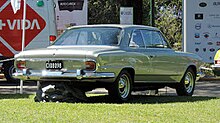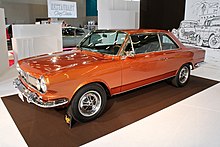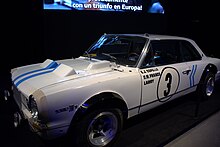Motor vehicle
| IKA-Renault Torino | |
|---|---|
 IKA Torino 380 coupé (1966-1970) IKA Torino 380 coupé (1966-1970) | |
| Overview | |
| Manufacturer | IKA (1966–1975) Renault Argentina (1975–1981) |
| Production | 1966–1981 |
| Assembly | Santa Isabel, Córdoba Province, Argentina |
| Designer | Dick Teague and Pininfarina |
| Body and chassis | |
| Class | Mid-size |
| Body style | 2-door hardtop coupé 4-door sedan |
| Layout | FR layout |
| Related | Rambler American (third generation) |
| Powertrain | |
| Engine |
|
| Transmission | 4-speed ZF manual |
| Dimensions | |
| Wheelbase | 107.2 in (2,723 mm) |
| Length | 4,724 mm (186.0 in) |
| Width | 1,798 mm (70.8 in) |
| Height | 1,410 mm (55.5 in) |
| Curb weight | 1,060–1,471 kg (2,337–3,243 lb) |
The IKA Torino, later renamed as Renault Torino, is a mid-sized automobile made by Industrias Kaiser Argentina (IKA) between 1966 and 1981, under an agreement with American Motors Corporation (AMC). The 1966 Torino was IKA's first national product. IKA was eventually bought out by Renault in 1975 to form Renault Argentina S.A.
The Torino was built on the same hybrid AMC platform through 1981 in both two-door hardtop and four-door sedan variants. It has been described as "Argentina's national car".
Background


In 1961, IKA (Industrias Kaiser Argentina) was looking for a car that could break into the Argentinian market, a car that could combine American reliability with European elegance. The automaker provided two 1965 Rambler Americans (a coupe hardtop and a sedan) to Pininfarina seeking styling updates. The new design largely maintained the general shape of the original Rambler with a completely new interior and facelifted "European" grille and rear end.
The car was presented on 30 November 1966, at the Autódromo Juan y Oscar Gálvez and was marketed as the quintessential Argentinian car. The Torino proved popular throughout the 1960s and the 1970s. It continued to be produced after IKA was bought out by Renault.
Renault continued the production until the early 1980s. In 1978 the Argentinian automobile market began to slow down considerably and this also coincided with the relaxation of trade restrictions and the introduction of foreign-made cars. The Torino was unable to compete with the newer, cheaper, more reliable foreign models. Production of the Torino line ended in 1982.
A total of 99,792 two and four-door IKA Torinos were built.
Engines
All engines were manufactured in Argentina.
- Tornado Special engine (only available on the 300/300S (4 doors)):
- Bore X Stroke: 84.94 mm x 87.31 mm
- Displacement: 2968 cc
- Top RPM: 5000 rpm
- Number of main bearings: 4
- Power: 120 hp (89 kW; 122 PS) at 4500 rpm and 26 kg⋅m (188 lb⋅ft; 255 N⋅m) at 3000 rpm

- Tornado Interceptor engine. Available models: 380, 380W, TS, SE, GS200.
- Bore X Stroke: 84.94 mm X 111.125 mm
- Displacement: 3770 cc
- Top RPM: 5000 rpm
- Number of main bearings: 4
- Power:
- 380/380S: 155 hp (116 kW; 157 PS) at 4300 rpm and 32 kg⋅m (231 lb⋅ft; 314 N⋅m) at 3500 rpm (380S is the 4 door Version)
- 380W: 176 hp (131 kW; 178 PS) at 4500 rpm and 33 kg⋅m (239 lb⋅ft; 324 N⋅m) at 3500 rpm (The W is for the 3 Weber 45 Dcoe 17 carburetors)
- TS: 160 hp (119 kW; 162 PS) at 4500 rpm and 31 kg⋅m (224 lb⋅ft; 304 N⋅m) at 2500 rpm
- TS/S: 152 hp (113 kW; 154 PS) at 4200 rpm and 30 kg⋅m (217 lb⋅ft; 294 N⋅m) at 2500 rpm (4 door)
- GS200: 185 hp (138 kW; 188 PS) at 4700 rpm and 34 kg⋅m (246 lb⋅ft; 333 N⋅m) at 3500 rpm *(The GS200 replaced the 380W and was the first Argentine car to be able to exceed 200 km/h, with a top speed of 203 km/h)

- The Torino 233 engine features a new block and a new cylinder head. Available models: SE, GR, TS, TSX, GS, ZX.
- Bore X Stroke: 84.94 mm x 111.125 mm
- Displacement: 3770 cc
- Top RPM: 5200 rpm
- Number of main bearings: 7
- Power:
- SE (4-door): 170 hp (127 kW; 172 PS) at 4500 rpm and 31 kg⋅m (224 lb⋅ft; 304 N⋅m) at 2500 rpm
- GR (4-door)/TS: 180 hp (134 kW; 182 PS) at 4500 rpm and 31 kg⋅m (224 lb⋅ft; 304 N⋅m)at 2500 rpm
- TSX: 200 hp (149 kW; 203 PS) at 4500 rpm and 33 kg⋅m (239 lb⋅ft; 324 N⋅m) at 3000 rpm
- GS: 215 hp (160 kW; 218 PS) at 4700 rpm and 34 kg⋅m (246 lb⋅ft; 333 N⋅m) at 3200 rpm (estimated)
- ZX: 200 hp (149 kW; 203 PS) at 4500 rpm and 33 kg⋅m (239 lb⋅ft; 324 N⋅m) at 3000 rpm
- The Tornado Interceptor 241 engine prepared for use in competition. Available in the Torino 380W TC.
- Bore X Stroke: 86.70 mm x 111.125 mm
- Displacement: 3950 cc
- Top RPM: 5400 rpm
- Number of main bearings: 4
- Power: 248 hp (185 kW; 251 PS) at 5000 rpm and 39 kg⋅m (282 lb⋅ft; 382 N⋅m) at 4000 rpm
Racing

A marketing effort was established by IKA, known as the "Argentine Mission of 1969" with coordination by engineer Oreste Berta and under the leadership of Juan Manuel Fangio because competing in auto racing was viewed as an investment in brand image.
The IKA Torino's most notable international success was in the Marathon de la Route race of 1969, with a Torino finishing in fourth place.
The factory modified three cars by reducing their weight from 1,407 to 1,365 kg (3,102 to 3,009 lb) and increasing the engine output to 250 hp (186 kW; 253 PS) at 5200 rpm to give them a top speed of 230 km/h (143 mph) as well as suspension adjustments using wider tires. The three cars were shipped to Germany and given numbers 1, 2, and 3 due to Fangio's renown in Europe as well as a special classification due to the car's larger engine displacement.
After the three and a half days of racing, the No. 3 Torino that was driven by Eduardo Copello, Alberto Rodriguez Larreta, and Oscar Mauricio Franco, had covered the most laps of all – 334, but lost the top position because they accumulated various penalties during the race. The IKA Torino became "the pride and joy of Argentine car enthusiasts" when their country's team "showed that it could run with the best of Europe on Europe’s toughest circuit." This became "one of the great feats of Argentine motorsport having managed to gather the support of the entire national industry in a feat that showed the world the potential of this model built entirely in the country."
The No. 3 car is displayed in the Juan Manuel Fangio Museum located in Balcarce, Buenos Aires Province, the birthplace of Argentina's Fangio who dominated the first decade of Formula One racing. When not competing on race tracks, Fangio's daily diver was a 1970 IKA Torino 380S four-door sedan. The car was a gift after the 1969 Nürburgring 84-hour race and Fangio drove it until he became president of Mercedes-Benz Argentina in 1974. the car remained in Fangio's name until his death in 1995 and then kept within his family until 2013. The car was auctioned with no reserve at the Silverstone NEC Classic Motor Show Sale in Birmingham, England for £28,175, or about $45,000.
The IKA Torino won the Turismo Carretera, a popular touring car racing series in Argentina in 1967 with Eduardo Copello, 1969 with Gastón Perkins, 1970 and 1971 with Rubén Luis di Palma and 2022 with José Manuel Urcera.
The Torino is still being raced, albeit in silhouette form with Jeep Cherokee engines, in the Argentinian Turismo Carretera and other series.
Legacy
By the late 1970s, the Torino was the only non-Renault product manufactured by the French company. It could also be considered the last front-engine, rear-wheel drive Renault, a rarity in itself.
Many Argentines think of the Torino as the national car. Parts are still available and there are fan clubs.
The appeal of the IKA Torino to collectors outside of Argentina is limited because exporting one is difficult due to numerous registration and ownership regulations.
References
- Durruty, Diego (15 July 2022). "Torino, el auto argentino que se ganó el cariño de la gente en la calle y la pista" [Torino, the Argentine car that won the affection of the people on the street and the track]. Automundo (in Spanish). Retrieved 17 July 2022.
... from its birth until now, it is the only model that has remained in the memory of Argentines.
- ^ Niedermeyer, Paul (9 January 2022). "1971 IKA Torino TS – The Legendary Rambler European South American". Curbside Classic. Retrieved 29 March 2022.
- Margeit, Rob (18 August 2020). "Cars you didn't know you want: IKA-Renault Torino". Drive. Retrieved 29 March 2022.
- Kierse, Matthias (5 February 2020). "Renault Torino". Secret Classics. Archived from the original on 5 February 2021. Retrieved 17 July 2022.
- ^ Sánchez, Miguel (January 2022). "El Torino and Fangio's Argentine Mission at the Nürburgring". La Escudería. Retrieved 17 July 2022.
- de Jong, Frank. "39. Marathon de la Route – Nürburgring 84 hours (1969)". touringcarracing.net. Retrieved 17 July 2022.
- ^ Orosz, Peter (8 March 2011). "When Argentina ruled the Nürburgring". Jalopnik. Retrieved 17 July 2022.
- Mihalascu, Dan (9 October 2013). "Fangio's Rare AMC-Based 1970 IKA Torino 380S Up for Auction". Carscoops. Retrieved 17 July 2022.
- Adolphus, David Traver (8 October 2013). "Fangio's other car: an Argentine IKA Torino". Road & Track. Retrieved 17 July 2022.
- Ernst, Kurt (19 November 2013). "Juan Manuel Fangio's 1970 IKA Torino 380S heads to auction". Hemmings. Retrieved 17 July 2022.
- "Renault Torino GR (1982 MY)". carfolio.com. Retrieved 17 July 2022.
- "Floyd Clymer's Soap Box". Autodriver. 67. Counterpoint: 4. 1967. Retrieved 17 July 2022 – via Google Books.
- Falconer, Tim (2008). Drive: A Road Trip Through Our Complicated Affair with the Automobile. Penguin Canada. ISBN 9780143179375. Retrieved 17 July 2022 – via Google Books.
Torino 380, a legendary racing car made by Industrias Kaiser Argentina. Some people consider it the country's national car, noted Coelho, adding proudly, 'It represents us.'
- Duisberg, Rich (4 March 2016). "Beautiful, quick, robust and cheap. The classic car you can't have". England: MotorPunk. Retrieved 17 July 2022.
External links
- Club Torino Argentino on Facebook
- Production numbers Archived 12 June 2013 at the Wayback Machine on Coche Argentino
- IKA-Renault Torino specifications: versions & types on Automobile-Catalog.com
| Automobiles |
| ||||||||||
|---|---|---|---|---|---|---|---|---|---|---|---|
| Other vehicles |
| ||||||||||
| Related topics | |||||||||||
| American Motors Corporation | ||||||||||||||||
|---|---|---|---|---|---|---|---|---|---|---|---|---|---|---|---|---|
| Vehicles |
|  | ||||||||||||||
| Affiliations | ||||||||||||||||
| People |
| |||||||||||||||
| Facilities | ||||||||||||||||
| Related topics | ||||||||||||||||
| American Motors Corporation (AMC) road car timeline, United States market, 1954–1987 Eagle » | ||||||||||||||||||||||||||||||||||||||||||||||||||||||||||||||||||||||||||||||||||||||||||||||||||||||||||||||||||||||||||||||||||||||||||||||||||||||||||||||||||||||||||||||||||||||||||||||||||||||||||||||||||||||||||||||||||||||||||||||||||||||||||||||||||||||||||||||||||||||||||||||||||||||||||||||||||||||||||||||||||||||||||||||||||||||||||||||||||||||||||||||||||||||||||||||||||||||||||||||||||||||||||||||||||||||||||||||||||||||||||||||||||||||||||||||||||||||||||||||||||||||||||||||||||||||||||||||||||||||||||||||||||||||||||||||||||||||||||||||||||||||||||||||||||||||||||||||
|---|---|---|---|---|---|---|---|---|---|---|---|---|---|---|---|---|---|---|---|---|---|---|---|---|---|---|---|---|---|---|---|---|---|---|---|---|---|---|---|---|---|---|---|---|---|---|---|---|---|---|---|---|---|---|---|---|---|---|---|---|---|---|---|---|---|---|---|---|---|---|---|---|---|---|---|---|---|---|---|---|---|---|---|---|---|---|---|---|---|---|---|---|---|---|---|---|---|---|---|---|---|---|---|---|---|---|---|---|---|---|---|---|---|---|---|---|---|---|---|---|---|---|---|---|---|---|---|---|---|---|---|---|---|---|---|---|---|---|---|---|---|---|---|---|---|---|---|---|---|---|---|---|---|---|---|---|---|---|---|---|---|---|---|---|---|---|---|---|---|---|---|---|---|---|---|---|---|---|---|---|---|---|---|---|---|---|---|---|---|---|---|---|---|---|---|---|---|---|---|---|---|---|---|---|---|---|---|---|---|---|---|---|---|---|---|---|---|---|---|---|---|---|---|---|---|---|---|---|---|---|---|---|---|---|---|---|---|---|---|---|---|---|---|---|---|---|---|---|---|---|---|---|---|---|---|---|---|---|---|---|---|---|---|---|---|---|---|---|---|---|---|---|---|---|---|---|---|---|---|---|---|---|---|---|---|---|---|---|---|---|---|---|---|---|---|---|---|---|---|---|---|---|---|---|---|---|---|---|---|---|---|---|---|---|---|---|---|---|---|---|---|---|---|---|---|---|---|---|---|---|---|---|---|---|---|---|---|---|---|---|---|---|---|---|---|---|---|---|---|---|---|---|---|---|---|---|---|---|---|---|---|---|---|---|---|---|---|---|---|---|---|---|---|---|---|---|---|---|---|---|---|---|---|---|---|---|---|---|---|---|---|---|---|---|---|---|---|---|---|---|---|---|---|---|---|---|---|---|---|---|---|---|---|---|---|---|---|---|---|---|---|---|---|---|---|---|---|---|---|---|---|---|---|---|---|---|---|---|---|---|---|---|---|---|---|---|---|---|---|---|---|---|---|---|---|---|---|---|---|---|---|---|---|---|---|---|---|---|---|---|---|---|---|---|---|---|---|---|---|---|---|---|---|---|---|---|---|---|---|---|---|---|---|---|---|---|---|---|---|---|---|---|---|---|---|---|---|---|---|---|---|---|---|---|---|---|---|---|---|---|---|---|---|---|---|---|---|---|---|---|---|---|---|---|---|---|---|---|---|---|---|---|---|---|---|---|---|---|---|---|---|---|---|---|---|---|---|---|---|---|---|---|---|---|---|---|---|---|---|---|---|---|---|---|---|---|---|---|---|---|---|---|---|---|---|---|---|---|---|---|
| ||||||||||||||||||||||||||||||||||||||||||||||||||||||||||||||||||||||||||||||||||||||||||||||||||||||||||||||||||||||||||||||||||||||||||||||||||||||||||||||||||||||||||||||||||||||||||||||||||||||||||||||||||||||||||||||||||||||||||||||||||||||||||||||||||||||||||||||||||||||||||||||||||||||||||||||||||||||||||||||||||||||||||||||||||||||||||||||||||||||||||||||||||||||||||||||||||||||||||||||||||||||||||||||||||||||||||||||||||||||||||||||||||||||||||||||||||||||||||||||||||||||||||||||||||||||||||||||||||||||||||||||||||||||||||||||||||||||||||||||||||||||||||||||||||||||||||||||
| Renault vehicles timeline, Latin American market, 1980s–2010s - next » | |||||||||||||||||||||||||||||||||||||||||||||||||||||||||||||||||||||||||||||||||||||||||||||||||||||||||||||||||||||||||||||||||||||||||||||||||||||||||||||||||||||||||||||||||||||||||||||||||||||||||||||||||||||||||||||||||||||||||||||||||||||||||||||||||||||||||||||||||||||||||||||||||||||||||||||||||||||||||||||||||||||||||||||||||||||||||||||||||||||||||||||||||||||||||||||||||||||||||||||||||||||||||||||||||||||||||||||||||||||||||||||||||||||||||||||||||||||||||||||||||||||||||||||||||||||||||||||||||||||||||||||||||||||||||||||||||||||||||||||||||||||||||||||||||||||||||||||||||||||||||||||||||||||||||||||||||||||||||||||||||||||||||||||||||||||||||||||||||||||||||||||||||||||||||||||||||||||||||||||||||||||||||||||||||||||||||||||||||||||||||||||||||||||||||||||||||||||||||||||||||||||||||||||||||||||||||||||||||||||||||||||||||||||||||||||||||||||||||||||||||||||||||||||||||||||||||||||||||||||||||||||||||||||||||||||||||||||||||||||||||||||||||||||||||||||||||||||||||||||||
|---|---|---|---|---|---|---|---|---|---|---|---|---|---|---|---|---|---|---|---|---|---|---|---|---|---|---|---|---|---|---|---|---|---|---|---|---|---|---|---|---|---|---|---|---|---|---|---|---|---|---|---|---|---|---|---|---|---|---|---|---|---|---|---|---|---|---|---|---|---|---|---|---|---|---|---|---|---|---|---|---|---|---|---|---|---|---|---|---|---|---|---|---|---|---|---|---|---|---|---|---|---|---|---|---|---|---|---|---|---|---|---|---|---|---|---|---|---|---|---|---|---|---|---|---|---|---|---|---|---|---|---|---|---|---|---|---|---|---|---|---|---|---|---|---|---|---|---|---|---|---|---|---|---|---|---|---|---|---|---|---|---|---|---|---|---|---|---|---|---|---|---|---|---|---|---|---|---|---|---|---|---|---|---|---|---|---|---|---|---|---|---|---|---|---|---|---|---|---|---|---|---|---|---|---|---|---|---|---|---|---|---|---|---|---|---|---|---|---|---|---|---|---|---|---|---|---|---|---|---|---|---|---|---|---|---|---|---|---|---|---|---|---|---|---|---|---|---|---|---|---|---|---|---|---|---|---|---|---|---|---|---|---|---|---|---|---|---|---|---|---|---|---|---|---|---|---|---|---|---|---|---|---|---|---|---|---|---|---|---|---|---|---|---|---|---|---|---|---|---|---|---|---|---|---|---|---|---|---|---|---|---|---|---|---|---|---|---|---|---|---|---|---|---|---|---|---|---|---|---|---|---|---|---|---|---|---|---|---|---|---|---|---|---|---|---|---|---|---|---|---|---|---|---|---|---|---|---|---|---|---|---|---|---|---|---|---|---|---|---|---|---|---|---|---|---|---|---|---|---|---|---|---|---|---|---|---|---|---|---|---|---|---|---|---|---|---|---|---|---|---|---|---|---|---|---|---|---|---|---|---|---|---|---|---|---|---|---|---|---|---|---|---|---|---|---|---|---|---|---|---|---|---|---|---|---|---|---|---|---|---|---|---|---|---|---|---|---|---|---|---|---|---|---|---|---|---|---|---|---|---|---|---|---|---|---|---|---|---|---|---|---|---|---|---|---|---|---|---|---|---|---|---|---|---|---|---|---|---|---|---|---|---|---|---|---|---|---|---|---|---|---|---|---|---|---|---|---|---|---|---|---|---|---|---|---|---|---|---|---|---|---|---|---|---|---|---|---|---|---|---|---|---|---|---|---|---|---|---|---|---|---|---|---|---|---|---|---|---|---|---|---|---|---|---|---|---|---|---|---|---|---|---|---|---|---|---|---|---|---|---|---|---|---|---|---|---|---|---|---|---|---|---|---|---|---|---|---|---|---|---|---|---|---|---|---|---|---|---|---|---|---|---|---|---|---|---|---|---|---|---|---|---|---|---|---|---|---|---|---|---|---|---|---|---|---|---|---|---|---|---|---|---|---|---|---|---|---|---|---|---|---|---|---|---|---|---|---|---|---|---|---|---|---|---|---|---|---|---|---|---|---|---|---|---|---|---|---|---|---|---|---|---|---|---|---|---|---|---|---|---|---|---|---|---|---|---|---|---|---|---|---|---|---|---|---|---|---|---|---|---|---|---|---|---|---|---|---|---|---|---|---|---|---|---|---|---|---|---|---|---|---|---|---|---|---|---|---|---|---|---|---|---|---|---|---|---|---|---|---|---|---|---|---|---|---|---|---|---|---|---|---|---|---|---|---|---|---|---|---|---|---|---|---|---|---|---|---|---|---|---|---|---|---|---|---|---|---|---|---|---|---|---|---|---|---|---|---|---|---|---|---|---|---|---|---|---|---|---|---|---|---|---|---|---|---|---|---|---|---|---|---|---|---|---|---|---|---|---|---|---|---|---|---|---|---|---|---|---|---|---|---|---|---|---|---|---|---|---|---|---|---|---|---|---|---|---|---|---|---|---|---|---|---|---|---|---|---|---|---|---|---|---|---|---|---|---|---|---|---|---|---|---|---|---|---|---|---|---|---|---|---|---|---|---|---|---|---|---|---|---|---|---|---|---|---|---|---|---|---|---|---|---|---|---|---|---|---|---|---|---|---|---|---|---|---|---|---|---|---|---|---|---|---|---|---|---|---|---|---|---|---|---|---|---|---|---|---|---|---|---|---|---|---|---|---|---|---|---|---|---|---|---|---|---|---|---|---|---|---|---|---|---|---|---|---|---|---|---|---|---|---|---|---|---|---|---|---|---|---|---|---|---|---|---|---|---|---|---|---|---|---|---|---|---|---|---|---|---|---|
| |||||||||||||||||||||||||||||||||||||||||||||||||||||||||||||||||||||||||||||||||||||||||||||||||||||||||||||||||||||||||||||||||||||||||||||||||||||||||||||||||||||||||||||||||||||||||||||||||||||||||||||||||||||||||||||||||||||||||||||||||||||||||||||||||||||||||||||||||||||||||||||||||||||||||||||||||||||||||||||||||||||||||||||||||||||||||||||||||||||||||||||||||||||||||||||||||||||||||||||||||||||||||||||||||||||||||||||||||||||||||||||||||||||||||||||||||||||||||||||||||||||||||||||||||||||||||||||||||||||||||||||||||||||||||||||||||||||||||||||||||||||||||||||||||||||||||||||||||||||||||||||||||||||||||||||||||||||||||||||||||||||||||||||||||||||||||||||||||||||||||||||||||||||||||||||||||||||||||||||||||||||||||||||||||||||||||||||||||||||||||||||||||||||||||||||||||||||||||||||||||||||||||||||||||||||||||||||||||||||||||||||||||||||||||||||||||||||||||||||||||||||||||||||||||||||||||||||||||||||||||||||||||||||||||||||||||||||||||||||||||||||||||||||||||||||||||||||||||||||||
| « previous — Renault car timeline, 1940s–1980s — next » | ||||||||||||||||||||||||||||||||||||||||||||||||||||||||||||||||||||||||||||||||||||||||||||||||||||||||||||||||||||||||||||||||||||||||||||||||||||||||||||||||||||||||||||||||||||||||||||||||||||||||||||||||||||||||||||||||||||||||||||||||||||||||||||||||||||||||||||||||||||||||||||||||||||||||||||||||||||||||||||||||||||||||||||||||||||||||||||||||||||||||||||||||||||||||||||||||||||||||||||||||||||||||||||||||||||||||||||||||||||||||||||||||||||||||||||||||||||||||||||||||||||||||||||||||||||||||||||||||||||||||||||||||||||||||||||||||||||||||||||||||||||||||||||||||||||||||||||||||||||||||||||||||||||||||||||||||||||||||||||||||||||||||||||||||||||||||||||||||||||||||||||||||||||||||||||||||||||||||||||||||||||||||||||||||||||||||||||||||||||||||||||||||||||||||||||||
|---|---|---|---|---|---|---|---|---|---|---|---|---|---|---|---|---|---|---|---|---|---|---|---|---|---|---|---|---|---|---|---|---|---|---|---|---|---|---|---|---|---|---|---|---|---|---|---|---|---|---|---|---|---|---|---|---|---|---|---|---|---|---|---|---|---|---|---|---|---|---|---|---|---|---|---|---|---|---|---|---|---|---|---|---|---|---|---|---|---|---|---|---|---|---|---|---|---|---|---|---|---|---|---|---|---|---|---|---|---|---|---|---|---|---|---|---|---|---|---|---|---|---|---|---|---|---|---|---|---|---|---|---|---|---|---|---|---|---|---|---|---|---|---|---|---|---|---|---|---|---|---|---|---|---|---|---|---|---|---|---|---|---|---|---|---|---|---|---|---|---|---|---|---|---|---|---|---|---|---|---|---|---|---|---|---|---|---|---|---|---|---|---|---|---|---|---|---|---|---|---|---|---|---|---|---|---|---|---|---|---|---|---|---|---|---|---|---|---|---|---|---|---|---|---|---|---|---|---|---|---|---|---|---|---|---|---|---|---|---|---|---|---|---|---|---|---|---|---|---|---|---|---|---|---|---|---|---|---|---|---|---|---|---|---|---|---|---|---|---|---|---|---|---|---|---|---|---|---|---|---|---|---|---|---|---|---|---|---|---|---|---|---|---|---|---|---|---|---|---|---|---|---|---|---|---|---|---|---|---|---|---|---|---|---|---|---|---|---|---|---|---|---|---|---|---|---|---|---|---|---|---|---|---|---|---|---|---|---|---|---|---|---|---|---|---|---|---|---|---|---|---|---|---|---|---|---|---|---|---|---|---|---|---|---|---|---|---|---|---|---|---|---|---|---|---|---|---|---|---|---|---|---|---|---|---|---|---|---|---|---|---|---|---|---|---|---|---|---|---|---|---|---|---|---|---|---|---|---|---|---|---|---|---|---|---|---|---|---|---|---|---|---|---|---|---|---|---|---|---|---|---|---|---|---|---|---|---|---|---|---|---|---|---|---|---|---|---|---|---|---|---|---|---|---|---|---|---|---|---|---|---|---|---|---|---|---|---|---|---|---|---|---|---|---|---|---|---|---|---|---|---|---|---|---|---|---|---|---|---|---|---|---|---|---|---|---|---|---|---|---|---|---|---|---|---|---|---|---|---|---|---|---|---|---|---|---|---|---|---|---|---|---|---|---|---|---|---|---|---|---|---|---|---|---|---|---|---|---|---|---|---|---|---|---|---|---|---|---|---|---|---|---|---|---|---|---|---|---|---|---|---|---|---|---|---|---|---|---|---|---|---|---|---|---|---|---|---|---|---|---|---|---|---|---|---|---|---|---|---|---|---|---|---|---|---|---|---|---|---|---|---|---|---|---|---|---|---|---|---|---|---|---|---|---|---|---|---|---|---|---|---|---|---|---|---|---|---|---|---|---|---|---|---|---|---|---|---|---|---|---|---|---|---|---|---|---|---|---|---|---|---|---|---|---|---|---|---|---|---|---|---|---|---|---|---|---|---|---|---|---|---|---|---|---|---|---|---|---|---|---|---|---|---|---|---|---|---|---|---|---|---|---|---|---|---|---|---|---|---|---|---|---|---|---|---|---|---|---|---|---|---|---|---|---|---|---|---|---|---|---|---|---|---|---|---|---|---|---|---|---|---|---|---|---|---|---|---|---|---|---|---|---|---|---|---|---|---|---|---|---|---|---|---|---|---|---|---|---|---|---|---|---|---|---|---|---|---|---|---|---|---|---|---|---|---|---|---|---|---|---|---|---|
| ||||||||||||||||||||||||||||||||||||||||||||||||||||||||||||||||||||||||||||||||||||||||||||||||||||||||||||||||||||||||||||||||||||||||||||||||||||||||||||||||||||||||||||||||||||||||||||||||||||||||||||||||||||||||||||||||||||||||||||||||||||||||||||||||||||||||||||||||||||||||||||||||||||||||||||||||||||||||||||||||||||||||||||||||||||||||||||||||||||||||||||||||||||||||||||||||||||||||||||||||||||||||||||||||||||||||||||||||||||||||||||||||||||||||||||||||||||||||||||||||||||||||||||||||||||||||||||||||||||||||||||||||||||||||||||||||||||||||||||||||||||||||||||||||||||||||||||||||||||||||||||||||||||||||||||||||||||||||||||||||||||||||||||||||||||||||||||||||||||||||||||||||||||||||||||||||||||||||||||||||||||||||||||||||||||||||||||||||||||||||||||||||||||||||||||||
| Turismo Carretera Champions | |
|---|---|
| Nine-time | |
| Seven-time | |
| Six-time | |
| Five-time | |
| Four-time | |
| Three-time | |
| Two-time | |
| One-time |
|
